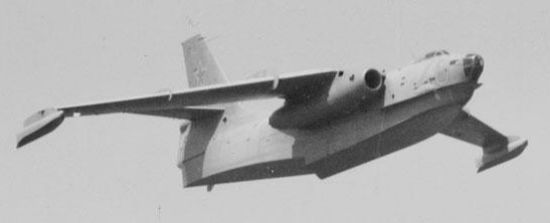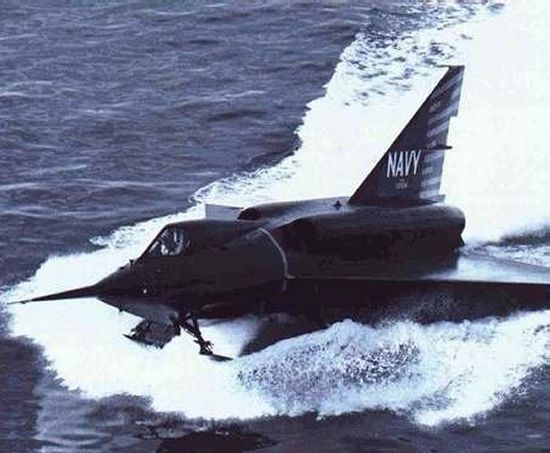|
||||||||||
|
|
||||||||||
|
||||||||||
|
|
||||||||||

Beriev had become the Soviet's primary manufacturer of flying boats during the 1930s, and most of its designs were generally similar to those developed by other nations around the world. The Be-10, however, was a significant departure because it was one of the first seaplanes to be powered by turbojet engines. The aircraft also built on early experience designing jet aircraft and incorporated swept wings, swept tail surfaces, wing fences, and other streamlined characteristics to improve high-speed performance. The Be-10 airframe was built entirely of metal, and its high-mounted swept wings with large anhedral featured stabilizing floats at each tip. Two Lyul'ka AL-7PB turbojet engines mounted near the wing root powered the aircraft. Carrying a crew of four or five, the Be-10 was designed for long-range maritime reconnaissance and anti-submarine patrols while carrying up to 4,400 lb (2,000 kg) of weapons.
The Be-10 was first unveiled to the public at the Soviet Aviation Day in 1961, and the aircraft soon captured no fewer than twelve world class records for seaplanes. Chief among these was the previously mentioned world speed record set by pilot Nikolai Andrievskii and a crew of two. Other records captured by the type included a speed record over a 1,000 km closed course while carrying a 5,000 kg payload and an altitude record while carrying a 10,000 kg payload. These and other records were recorded by the Fédération Aéronautique Internationale, or FAI, the international body that officially recognizes aviation and space records. Most of the records set by the M-10 still stand to this day.
The Be-10 is still considered the only jet-powered flying boat to ever achieve production status. Despite its revolutionary design and many records, however, the type saw only limited production. The Soviets instead favored the Be-12 that used much the same fuselage as the Be-10 mated to a more conventional wing and tail unit. Furthermore, the Be-12 was equipped with turboprop engines to provide much better efficiency than the fuel-hungry turbojets of the Be-10. This change in powerplant gave the Be-12 much better endurance for its maritime patrol duties.
The second aircraft you mention in your question is the Convair F2Y-1 Sea Dart, later redesignated as the F-7. The Sea Dart was truly one of the most unusual of the early experiments with jet-powered aircraft. Bearing a strong resemblance to contemporary Convair fighters like the F-102 and F-106, the Sea Dart was a single-seat, delta wing, jet-powered fighter capable of operating from water. The concept was originally pursued by the US Navy as a means of operating high-performance jets in forward areas without need of a land base or ship.

The Navy sponsored a competition that was won by a Convair design featuring unique retractable hydro-skis on which the aircraft could operate from the water. These skis produced enough hydrodynamic lift to raise the aircraft up and out of the water during takeoff, and they could be retracted into the fuselage during flight.
The unusual plane was powered by two Westinghouse turbojet engines with inlets mounted above the wings to minimize ingestion of water spray. A total of five test aircraft were built including one XF2Y-1 prototype and four YF2Y-1 pre-production aircraft. A further twelve F2Y-1 production models were also ordered. The XF2Y-1 prototype equipped with Westinghouse J34-WE-32 turbojets made its first test flight on 9 April 1953, but was found to be underpowered. Later aircraft were upgraded with the more powerful J46-WE-2 afterburning turbojets that required modification to the aft fuselage to accept the afterburners.
It was in this form that the initial YF2Y-1 became the first (and so far only) seaplane to reach supersonic speeds on 3 August 1954. Flown by Convair test pilot Charles Richbourg, the Sea Dart was only able to exceed the speed of sound while in a shallow dive and not while in level flight. This limitation was probably surmountable if the fuselage had been shaped to conform to the area rule, a modification that was planned for an improved model called the F2Y-2.

Unfortunately, the Sea Dart became mired in a number of problems before its true potential could be realized. The greatest technical challenge remaining was severe vibration experienced by the hydro-skis. Convair used the XF2Y-1 to test a new approach using a single ski that corrected much of the problem. Additional ski designs were also tested on this aircraft and the second YF2Y-1, the final test model to fly, but none was entirely satisfactory.
Further development was largely overcome by events when the first YF2Y-1 was destroyed in a spectacular crash at San Diego on 4 November 1954 killing test pilot Charles Richbourg. By this time, the Navy had essentially abandoned the operational concept for the Sea Dart anyway, and orders for production F2Y-1 and F2Y-2 aircraft were cancelled. The remaining two YF2Y-1 models that had been ordered were completed, but these were immediately placed in storage and never flown. Only the XF2Y-1 and second YF2Y-1 continued in limited use for test purposes, but both were placed in storage by 1957 when the program was officially cancelled.
These four surviving aircraft still remain today. The XF2Y-1 is in the possession of the National Air & Space Museum Paul Garber Facility but is in poor condition and awaits restoration. The three YF2Y-1 aircraft are currently on display at the San Diego Aerospace Museum, the Wings of Freedom Museum at NAS Willow Grove, Pennsylvania, and the Sun n' Fun Air Museum at Lakeland, Florida.
That brings us back to your question. At this point, I'm sure you're wondering how a plane that was incapable of reaching supersonic speeds holds the official record for fastest seaplane while another that did fly supersonic does not. The key word is official record. The performance of the Beriev M-10 was recorded by the FAI and is therefore considered to be an official record, but no Sea Dart flight was ever observed by this international body.
There are several other official speed records that have probably been broken as well. A good example is the
turboprop speed record held by the Tupolev Tu-114 commercial
airliner. This record most likely truly belongs to the related Tu-95
military bomber, but the latter plane was never observed by the FAI. We strive to present official records on this
site whenever possible since these are recognized by an impartial international organization. Unofficial records
like that held by the Sea Dart are known to exist but are more difficult to prove or defend.
- answer by Joe Yoon, 22 August 2004
Related Topics:
What is the fastest passenger aircraft on commercial flights? What is the speed of Concorde?
Read More Articles:


|
Aircraft | Design | Ask Us | Shop | Search |

|
|
| About Us | Contact Us | Copyright © 1997- | |||
|
|
|||